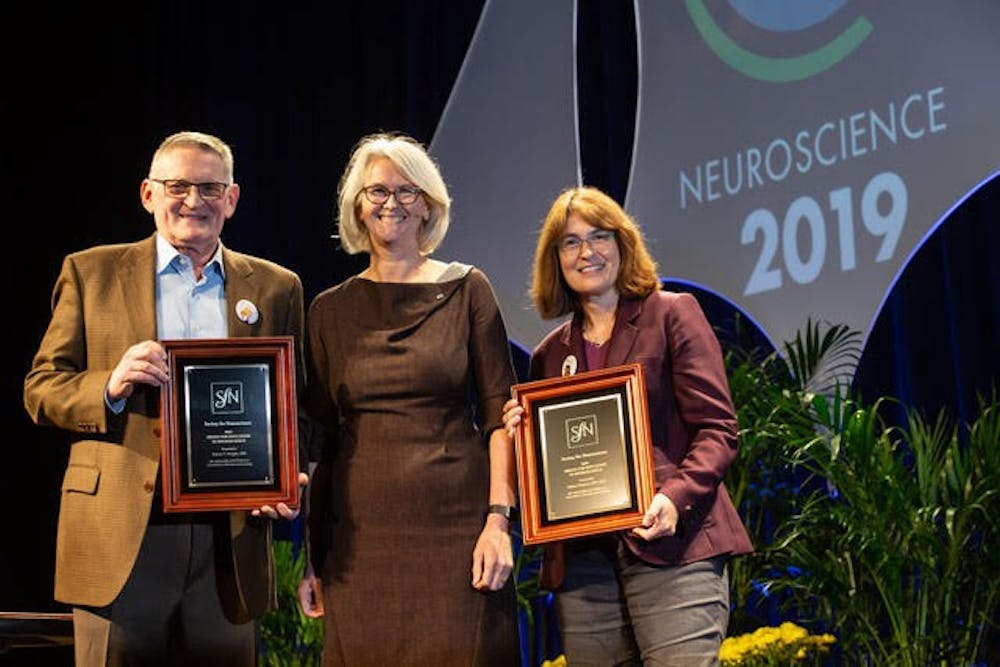University professor Sabine Kastner accepted the Society for Neuroscience’s Award for Education in Neuroscience on Monday, Oct. 21, in Chicago. The award honors her dedication to making neuroscience engaging for young audiences, specifically in creating an academic journal for and edited by children and teens.
Kastner shares the education award with Robert Knight, a professor of psychology and neuroscience at the University of California, Berkeley. Together, Kastner and Knight founded Frontiers for Young Minds, an open-access online journal that sparks interest in science and promotes youth involvement in the publishing process. Kastner is a professor of psychology at the Princeton Neuroscience Institute and has been at the University since 2000.
“Kids are incredibly curious [about neuroscience], but unfortunately that curiosity is not often met,” Kastner said. “Science has an enormous speed. There are daily discoveries, and for the kids it’s really important to learn about science as it happens … [because] it will help them become our science leaders of tomorrow.”
Frontiers for Young Minds features articles about novel developments in various fields of natural science. These articles are specifically written for a target audience of students from ages eight to 15. The process of editing for clarity and accessibility by children in this age range facilitates connections between young scientists and elementary to middle school students.
Students can sign up through the website to become reviewers as individuals, in groups, or even with their whole classroom. Each young reviewer is paired with a mentor, who serves as their point of contact as they formulate feedback on articles. These pairings can be as geographically disparate as a child in Pakistan working with a graduate student in Knight’s lab at Berkeley. Modeled on the peer review process in academia, the author revises based on the child’s feedback before the paper is published on the site.
“[This process] makes the papers better, and it gives a corpus of scientific papers that got a seal of approval from kids,” said Knight. “Kids feel empowered because their voice is being heard, and the mentors really enjoy this interaction.”
Knight also emphasized the benefit this platform has for teachers in STEM education as well as the students.
Kastner noted that the website has had readers from nearly every single country in the world. In founding the journal six years ago from what Kastner called a “grassroots movement,” Kastner and Knight tried to ensure that it would be free and accessible to all. Part of their initial vision was to reach schoolchildren in poorly resourced areas where this degree of exposure to science would not otherwise be available.

Dr. Gideon Caplovitz, an editor for the neuroscience section of the journal and a professor of psychology at the University of Nevada, Reno, nominated Kastner and Knight for this award. He mentioned that in his school district in Reno, he has noticed the need for this kind of platform.
“The teachers love it, the students love it, the feedback is incredible — and there’s appetite for more and more,” Caplovitz said. “These teachers really want to use their class time for this, even though it’s not going to check a Common Core box.”
Kastner’s individual research focuses on the neural basis of cognition in humans and animals, aiming to answer questions about how the brain represents the visual world and how information selection guides behavior. Both she and Knight had done significant work with school-aged children in their surrounding areas before creating the journal, but both recognized a need to reach a larger audience.
“Each of them has a tremendous, tremendous track record of mentorship, of fostering community, of outreach in their own ways,” Caplovitz said of the pair. “This is not coming out of a vacuum; it is a culmination of a career.”

The Society for Neuroscience is the largest organization to support and represent neuroscience research in the world. With membership at 37,000 from 95 countries, they are the “gold standard,” according to Caplovitz, for all things neuroscience. He nominated Kastner and Knight not only to give them a “high five” for the risk they took in delving into this project, but also to increase visibility for Frontiers for Young Minds.
All three interviewees agreed that the next step for the website is to translate it into more languages. Currently available in English and Hebrew, they are working on making the journal available in Spanish, Portuguese, and Mandarin. Kastner said that her long term goal for Frontiers for Young Minds is to make it a globally accessible platform.
“An educated society is a better society, and what better place to start than kids learning the value of science?” Knight said.








